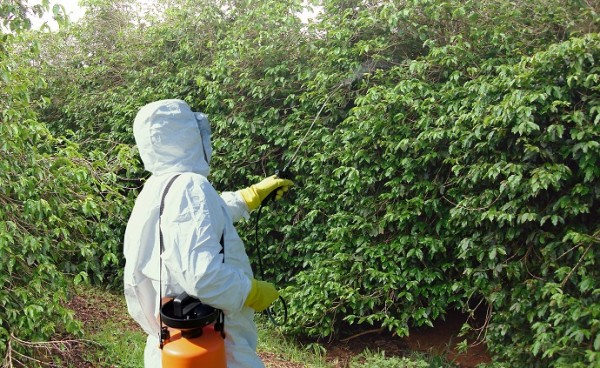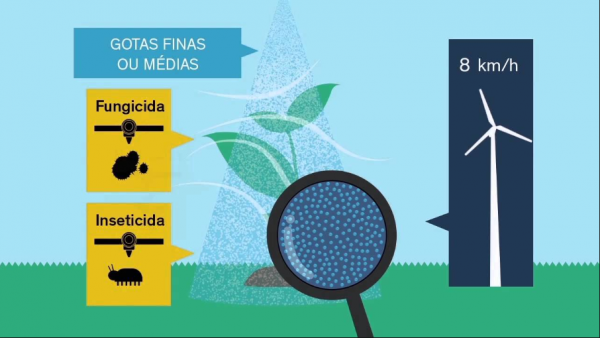
Good Farming Practices, including Technology for Pesticide Use, has been gaining momentum in discussions about sustainability in agriculture.
After the decision to chemically control pests, diseases and weeds or spontaneous plants, one must pay close attention to a series of steps related to safety and efficacy to ensure this is done in a correct and safe manner.
First, it is important to conduct a precise analysis of the agricultural plantation and answer some initial questions to determine the phytosanitary treatment and ensure good agronomic results: What is the biological target (pest, disease or spontaneous plant/weed) that needs to be controlled/managed? What is the most recommended treatment for such control? How should it be applied to grant effective results? Misapplication or failure to follow label instructions and Good Farming Practices may—in addition to causing losses and waste—considerably increase the risks of contamination for people, environment and non-target organisms.
Losses may occur due to uncontrolled drift, leaching or runoff, and may reach non-target areas—such as urban or environmental protection areas—as well as passers-by or pets. For optimum performance, it is essential to train and use workers that took the course on Regulating Norm 31 for effective use of application equipment, and always follow the instructions and recommendations of product label and insert as well as the instructions of the agricultural engineer in charge.
The Phytosanitary Product Application Technology encompasses the employment of all scientific knowledge for the correct use of a certain biologically active chemical in the target, considering the right amount, in a way that is economically viable, and with minimum contamination of other areas.
Spraying is the physical-chemical process of turning a liquid substance into particles or droplets. Pesticide application is the placement of droplets on a desired target, in size and density suitable to the objective proposed. Any change in droplet size or density may significantly jeopardize application quality.
When thinking about spraying, one should have in mind that factors such as the target to be achieved, the characteristics of the product used, the machine, the timing of the application and weather and environmental conditions will not be acting in isolation. The interaction of these factors is directly responsible for the efficacy or inefficacy of the control. Disregarding or mis-equating any of these interactions may lead to failure of the operation. Therefore, verifying the local characteristics in the moments that precede the application, such as wind speed, temperature, relative humidity and weather forecast, are paramount to determine application success or failure.
Below are some important steps to be taken/verified:
a) Keep the spray mixture agitated: Particularly for Wettable powder (WP) or suspension concentrate (SC) formulations, because of the risk they settle to the bottom of the sprayer when not agitated efficiently. Emulsifiable concentrate (EC) solutions tend to migrate to the surface, leading to poor distribution even when the dose per area is correct.
b) Importance of the right filters: Wettable powders (WP) or suspension concentrate (SC) formulations have solid particles in suspension in the spray mixture and the diameter of the powder particles may be greater than that of a very thin mesh.
c) Equipment regulation and calibration: adjust machine components to the characteristics of the crop and products that will be used. Attention to tip types, nozzle spacing, bar height, speed adjustment, etc. Verify tip flow and determine the application volume and product amount to be placed in the tank. This step is essential to ensure application quality and avoid significant losses of time and product.
The spraying volume to be used will depend on factors such as the desired target, the type of tip used, weather conditions, plant architecture and type of product to be applied. Also, droplets should be chosen carefully to be appropriate to local weather conditions, particularly regarding relative humidity. Spray droplets that may rise or move out the application area should be avoided. Herbicide applications may cause irreversible damage if they hit anything more than weeds.
Any amount of chemical that does not hit the target will bear no efficacy and represents some loss.
Thus, application efficacy is closely related to the volume that actually hits the target, and not the total volume sprayed, either directly (when the product is put in contact with the target at the time of application) or indirectly (when it hits the target later in the redistribution process—which may take place through systemic translocation, translaminar movement or superficial displacement from initial product application).

As for sprayers, all items recommended by the manufacturer should be checked for calibration and adjustments, cleaning and sanitizing conditions, safety, presence of leaks and weather conditions.
Pesticide drift, by definition, is the airborne movement of the spray mixture to an unintended target. Drift can be caused by wind, leakages or even diluent or product volatilization. It is one of the main causes of applicator/environment contamination and application failure.
When applying phytosanitary product to the total area of a crop (targeting its leaf portion), many droplets may go past the foliage and hit the soil, especially interlines. Other droplets that reach the leaves may clump together in such a way they are no longer retained and run down to the ground. These internal losses, that is, within the crop area, are closely linked to high volume applications with large droplets that generally exceed the maximum net retention capacity of the leaf surface. The displacement of droplets outside the crop area, caused by the action of the wind and evaporation of the water used in the spray mixture, especially in smaller droplets, is called “Exo-drift”. This type of external loss is one of the main causes of damages to other sensitive crops and environmental contamination. The main cause of drift is droplet size. The size of the droplet produced by the spraying nozzle will depend on the tip type, flow, spray angle, and properties of the liquid sprayed. Smaller droplets tend to be most prone to drift. Special attention should be paid to weather conditions, particularly air currents and atmospheric temperature inversions.
As for the environment, actions should be taken to protect bodies of water and permanent protection areas and legal reserves to avoid contamination and preserve the local flora and fauna. In relation to applicator safety, it is essential to wear the appropriate and sanitized personal protection equipment each time pesticides are applied. The preharvest interval—which is the wait time between the last pesticide application and the crop harvest—must be met for the plant to metabolize the absorbed chemical compounds and not have residues above the limits that may be harmful to humans.
To close, it is important to highlight that issues related to food safety (particularly meeting the Maximum Residue Levels of each of the pesticides used) is essential to ensure the quality of the food produced, in addition to avoiding trade restrictions. For exported foods, the individual regulations of each of the export-target countries must be verified and special attention should be given to the maximum level of each specific residue.
Therefore, compliance with the instructions and guidelines on pesticide labels and inserts is a must since it plays an important role in raising growers’ awareness and avoiding any trade restrictions between countries.
Marcos Matos – CECAFÉ CEO
Lilian Vendrametto – CECAFÉ Sustainability Manager


Leave A Comment